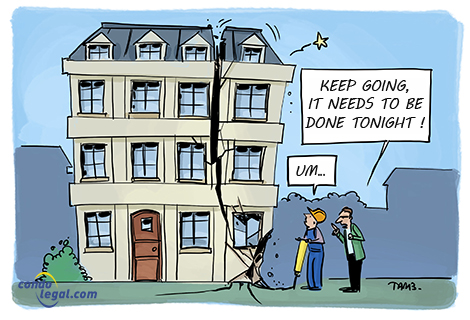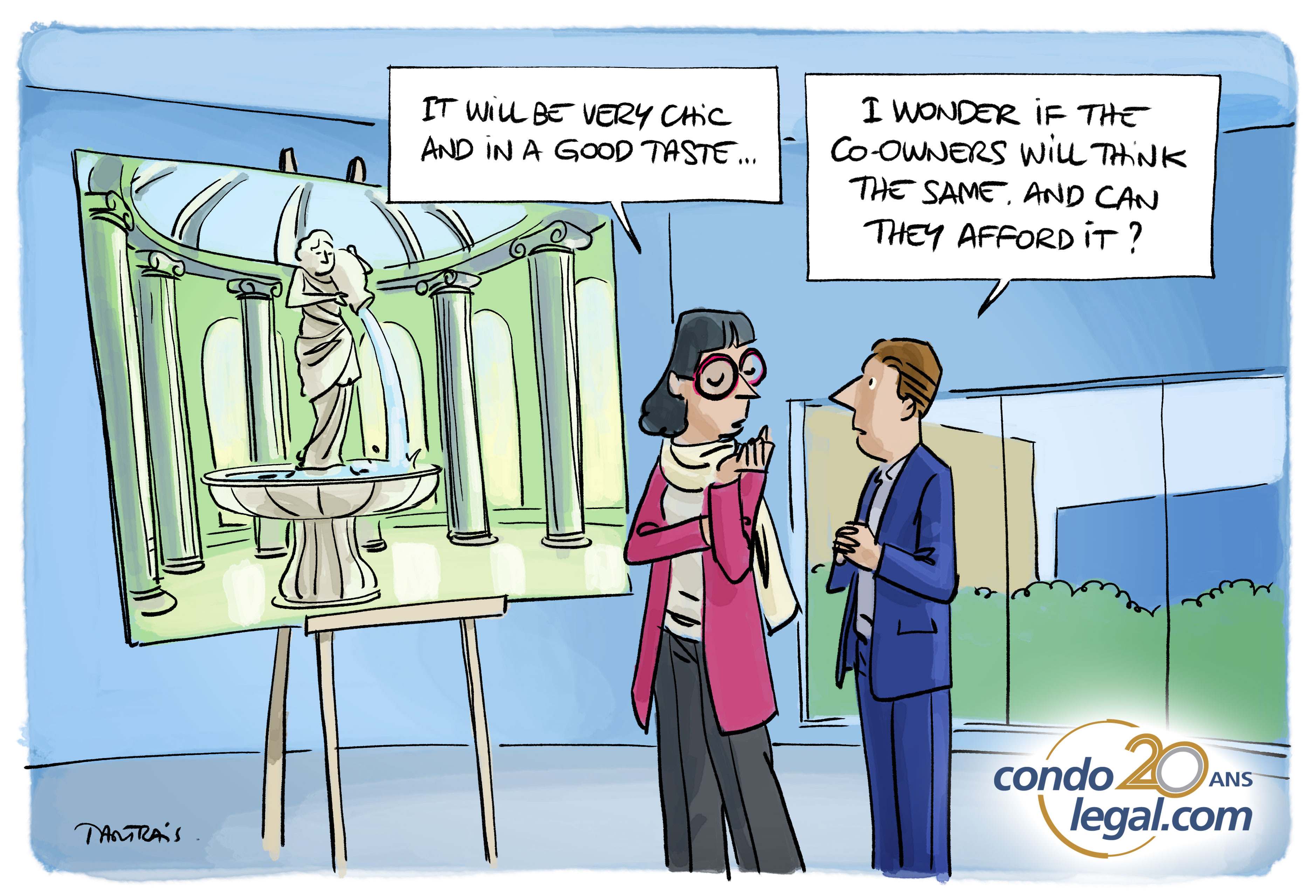 The contingency fund is set up on the basis of forward planning limited to certain work namely that which the purpose is the preservation of the common portions; thus, this collective saving allows to finance the execution of work allowing the rehabilitation of the common portions as well as the common portions for restricted use. The contingency fund must be used to pay the cost of very specific work namely that related to major repairs or the replacement of the common portions of the immovable.
The contingency fund is set up on the basis of forward planning limited to certain work namely that which the purpose is the preservation of the common portions; thus, this collective saving allows to finance the execution of work allowing the rehabilitation of the common portions as well as the common portions for restricted use. The contingency fund must be used to pay the cost of very specific work namely that related to major repairs or the replacement of the common portions of the immovable.
Major repairs
Section 1152 of the Civil Code of Québec relating to usufruct specifies that "major repairs are those which affect a substantial part of the property and require extraordinary outlays such as repairs relating to beams and support walls, to the replacement of roofs, to retaining walls, to heating, electrical, plumbing or electronic systems and, with respect to movables, to motive parts or the casing of the property".
Also, it's important to understand that the term "exceptional" must be understood as "not occurring regularly". This interpretation is in line with the distinction made by the legislation of British Columbia between repairs under the general administration fund which are destined to daily operations and those to be charged to the contingency fund; the first ones usually occur once or more a year whereas the second ones occur less often if not rarely. Furthermore, section 1152 of the Civil Code of Québec necessarily excludes minor repairs, improvement work and the current administrative costs of the syndicate of co-owners.
Replacement of the common portions
The replacement of the common portions is work whose cost is not included in the operating budget of the co-ownership (condominium); this is work that ensures the preservation of the common portions excluding maintenance such as the replacement of the elevator. For instance, the replacement of windows that have become obsolete as a result of a progressive deterioration or affected by a construction defect constitutes an expense to be charged to the contingency fund whereas the repair of a broken window caused by the co-owner holding the exclusive use or a third party member consists more of regular maintenance.
Identification of the common portions
Before charging an expense to the contingency fund related to work, the board of directors must identify precisely the common portions of the immovable; the determination of the common portions requires firstly an examination of the provisions of the declaration of co-ownership stating these portions of the immovable as well as the cadastral plan which allows to know the limits and measures of each lot.
Professional fees
The professional fees of the building such as those of the architect, the engineer or the professional technologist whose services are retained in the context of major repairs or the replacement of the common portions are expenses admissible to the contingency fund.
Presumption regarding the common portions
Despite the indications in the declaration of co-ownership, the boundary between common and private portions is sometimes difficult to determine. In certain circumstances, when the declaration of co-ownership lacks clarity, the law presumes certain portions of the co-ownership to be "common"; this includes the ground, yards, balconies, parks, gardens, access roads, stairways and elevators, passageways and halls, common service areas, parking and storage areas, basements, the main walls of buildings, common equipment and appliances such as central heating and air-conditioning systems, as piping and wiring. It is important to note that all these elements can be considered common portions even when they cross private portions; however, this presumption is not absolute, as it can be refuted by the cadastral plan that provides for the immatriculation of private and common portions of the co-ownership, or by the declaration of co-ownership when it describes in detail their composition and respective boundaries.
 WHAT YOU SHOULD KNOW ! Work to bring the common portions up to standard is not considered to be improvements. The resulting expenses are covered by the contingency fund if they are major repairs or replacement of the common portions. As for the method of financing this work, it is up to the board of directors to determine it.
WHAT YOU SHOULD KNOW ! Work to bring the common portions up to standard is not considered to be improvements. The resulting expenses are covered by the contingency fund if they are major repairs or replacement of the common portions. As for the method of financing this work, it is up to the board of directors to determine it.
 WHAT TO KEEP IN MIND : While the Civil Code of Quebec provides valuable guidance, some declarations of co-ownership remain difficult to interpret as they constitute common and private portions. In this case, the board of directors must be assisted by an experienced lawyer or notary specialized in co-ownership. This first operation of identification of the common elements, once completed, should no longer require any revision for the future, since there are no subsequent modifications made to the building.
WHAT TO KEEP IN MIND : While the Civil Code of Quebec provides valuable guidance, some declarations of co-ownership remain difficult to interpret as they constitute common and private portions. In this case, the board of directors must be assisted by an experienced lawyer or notary specialized in co-ownership. This first operation of identification of the common elements, once completed, should no longer require any revision for the future, since there are no subsequent modifications made to the building.
 WARNING ! It should be noted that a declaration of co-ownership may contain errors with regard to the determination of common and private portions. Thus, the fenestration of the immovable could be incorrectly described in the constituting deed of co-ownership as being a private portion, whereas the combined analysis of the descriptive state of the fractions and the cadastral plan made it possible to conclude that the fenestration was included in the common portion.
WARNING ! It should be noted that a declaration of co-ownership may contain errors with regard to the determination of common and private portions. Thus, the fenestration of the immovable could be incorrectly described in the constituting deed of co-ownership as being a private portion, whereas the combined analysis of the descriptive state of the fractions and the cadastral plan made it possible to conclude that the fenestration was included in the common portion.




